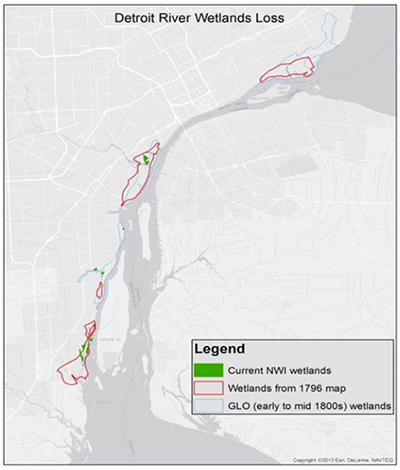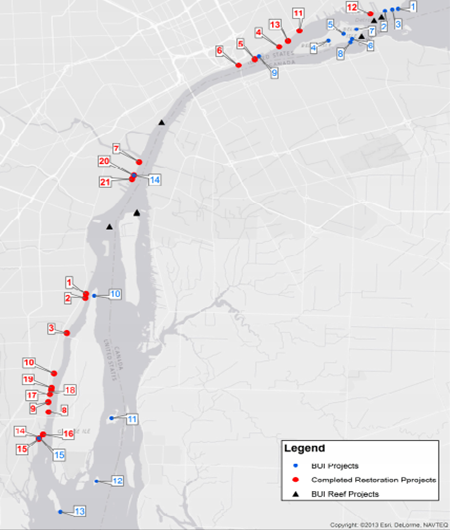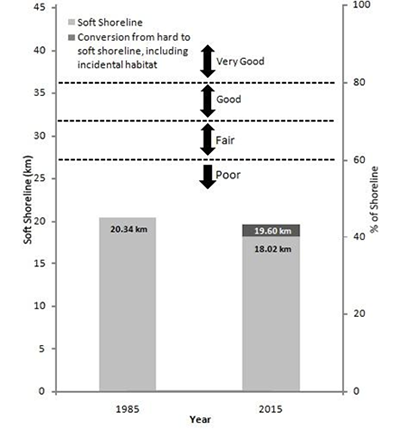Detroit River-Western Lake Erie Basin Indicator Project
Soft Shoreline Engineering Along the Detroit River
Authors
John Hartig, University of Windsor, Great Lakes Institute for Environmental Research, jhhartig@uwindsor.caCollin Knauss, University of Michigan - School for Environment and Sustainability, crknauss@umich.edu
Background
The Detroit River is a 43.5 km international connecting channel that sits in the middle of the Great Lakes and serves as a vital connection between the upper Great Lakes to the lower Great Lakes (Hartig and Bennion 2017). The Detroit River has been a critical international shipping route since the early 1820s and today remains one of the busiest navigational channels in the United States (Bennion and Manny 2011, U.S. Army Corps of Engineers 2004). Human population densities in U.S. and Canadian portions of the Detroit River watershed are nearly 4,000,000 and 390,000, respectively (Hartig and Bennion 2017).
To support industry and commerce, shipping channels were created as part of the Great Lakes-St. Lawrence Seaway System. The creation of these shipping channels and expansion of industry and commerce resulted in considerable loss and degradation of aquatic habitats. For example, since 1874 a variety of anthropogenic activities, including urbanization, industrialization, dredging, dredge spoils disposal, channelization, and shoreline hardening, have transformed the channel morphology, altered the natural river flow, and degraded habitats (Bennion and Manny 2011, Caulk et al. 2000). Between 1874 to 1968, nearly 100 km of navigational channels were created by removing more than 46,200,000 m3 of rock and sediment from over 40.5 km2 of river bottom (Bennion and Manny 2011). To support shipping, industry, and commerce, hard shoreline engineering became a common practice. Hard shoreline engineering utilizes concrete breakwaters or steel sheet piling to (1) stabilize shorelines for protection from flooding and erosion, (2) provide greater human safety, and/or (3) enhance commercial navigation or industrial development (Caulk et al. 2000, Hartig an Bennion 2017).
As one of the most biologically rich and diverse areas in the Great Lakes region, the Detroit River shoreline provides critical habitat for numerous fish and wildlife species (Bull and Craves 2003). Hard shoreline engineering, while beneficial for commercial, navigational, and industrial uses, typically has negative ecological value, often restricting critical fish and wildlife habitat (Caulk et al. 2000). In addition to habitat loss, shoreline hardening alters sediment transport processes, including the interchange between accretion and erosion, which then influences down river deposition (Patrick et al. 2016). As seen in Figure 1, human development, industrialization, and shoreline hardening along the Detroit River have contributed to a 97% loss of coastal wetland habitat (Manny 2003).

Figure 1. Extent of wetlands loss along the U.S. mainland of the Detroit River (base map credit: map created using ArcGIS® software by Esri (ArcMap 10.4.1)) (Hartig and Bennion 2017)
To address the negative impacts of shoreline hardening on the Detroit River’s ecological health, there has been growing interest in the practice of soft shoreline engineering, which utilizes ecological principles and practices to reduce erosion, improve shoreline stability, enhance habitat quality, and improve aesthetics (Hartig et al. 2001, Caulk et al. 2000). Soft shoreline engineering is accomplished using a variety of materials and vegetation to restore the land-water interface by strengthening ecological elements without sacrificing engineered shoreline integrity (Hartig and Bennion 2017). Figure 2 shows before and after photos of the Rouge Power Plant in River Rouge, Michigan, as an example of soft shoreline engineering along the Detroit River.

Figure 2. Before (left) and after photos of the Rouge Power Plant in River Rouge, MI (Hartig and Bennion 2017).
Status and Trends
In July of 1998, the Detroit River was designated as an American Heritage River by Presidential Executive Order. Under the Greater Detroit American Heritage River Initiative, a group of U.S. and Canadian researchers and resource managers convened a conference on soft shoreline engineering in 1999 (Hartig and Bennion 2017). Out of this conference, a Best Management Practices for Soft Engineering of Shorelines manual emerged that encouraged and galvanized support for using soft shoreline engineering techniques (Caulk et al. 2000).
Between 1995 and 2016, 19 shoreline habitat modification projects were completed along the U.S. portion of the Detroit River (Hartig and Bennion 2017). These projects involved either soft shoreline engineering, incidental habitat, or switching from steel sheet piling or concrete breakwaters to a limestone rip-rap with some minimal habitat features. Eight of the 19 projects involved soft shoreline engineering, seven represented shoreline conversion to limestone rip-rap, and four provided incidental habitat to structures. Figure 3 shows the locations of the soft shoreline engineering projects during the 21-year period along the Detroit River.

Figure 3. Soft shoreline engineering project locations along the Detroit River (Hartig and Bennion 2017).
Following the 2012 amendments to the Great Lakes Water Quality Agreement, the Lake Erie Biodiversity Conservation Strategy was developed as a binational initiative intended to support assessments of the lake’s biodiversity and challenges (Pearsall et al. 2012, Hartig and Bennion 2017). Additionally, the strategy created specific plans and actions to promote native biodiversity of Lake Erie, which included the lake itself, connecting channels (i.e., Detroit River), and adjacent watersheds (Hartig and Bennion 2017). Through this effort, several science-based targets were developed to support biodiversity conservation, including the following soft shoreline targets to sustain critical habitats for native species in the Detroit River (Hartig and Bennion 2017, Pearsall et al. 2012):
- less than 60% soft shoreline—poor quality
- 60–70% soft shoreline—fair quality
- 70–80% soft shoreline—good quality
- >80% soft shoreline—very good quality.
The 19 shoreline habitat modification projects resulted in improving 4.93 km of shoreline habitat. However, a comparison between 1985 and 2015 georeferenced aerial imagery showed that 2.32 km of soft shoreline changed to hard shoreline. It is important to note that 11 of the 19 shoreline habitat modification projects on the Detroit River were already georeferenced at “soft” in 1985 (Hartig and Bennion 2017). Three of the projects covering 360 m changed the shoreline from “hard” to “soft”, while the five remaining projects added 1.22 km of incidental habitat to hardened shoreline. Surprisingly, even with the addition of 1.58 km of soft shoreline and incidental habitat, there was an overall decline of 0.74 km of soft shoreline from 1985 to 2015 (Figure 4). In order for the Detroit River to attain a good state of at least 70% soft shoreline, an additional 12.1 km of soft shoreline will have to be added (Hartig and Bennion 2017).

Figure 4. The extent of soft shoreline along the U.S. mainland of the Detroit River as measured by georeferenced aerial imagery, 1985 and 2015 (Hartig and Bennion 2017).
Management Next Steps
Despite current management efforts by resource managers and conservation organizations, shoreline hardening continues to outpace soft shoreline engineering along the Detroit River. Potential reasons for this overall loss include insufficient training among planners and designers, absence of “habitat champions” at the design stage of urban waterfront redevelopment projects, and perceived risks accompanying soft engineering alternatives (Hartig and Bennion 2017). For long-term shoreline habitat goals to be realized, continuous and vigorous oversight of soft shoreline engineering projects will be necessary.
Going forward, resource managers should focus efforts on moving beyond opportunistic habitat enhancement/improvement project goals towards more holistic ecosystem-based management goals. Greater emphasis should be placed on identification, quantification, and understanding of critical habitats needed for target species management within an ecosystem framework. While restoration of the shoreline habitat along the Detroit River will be a long-term process, urban waterfront redevelopment projects should engage habitat experts early in the design stages, when key decisions are often made. Projects should further establish broad-based objectives for soft-shoreline engineering, with measurable targets for success and integrated technical support.
Specific recommendations for management organizations to help further adopt soft-shoreline engineering techniques include (Hartig and Bennion 2017):
- Work with state and federal regulatory agencies to integrate soft shoreline engineering into permitting processes and if hard engineering is needed for port operations, marina development, or residential development, state and federal agencies should promote incidental habitat engineering;
- Ensure habitat projects recruit many partners to leverage resources;
- Start with demonstration projects;
- Undertake habitat modification projects that support learning and education, where hypotheses are created and tested using scientific rigor and rationale;
- Engage citizen scientists, volunteers, university students, and/or researchers in monitoring and post-project monitoring;
- Measure environmental and social benefits from projects and communicate successes; and
- Advocate for public education and outreach, especially events that highlight project successes and benefits.
Research/Monitoring Needs
Post-project monitoring of soft shoreline projects is often lacking. This could be rectified by: incorporating pre- and post-project monitoring of effectiveness into all federal and state permits for habitat modification; ensuring that any shoreline restoration grants include post-project monitoring; and working with conservation partners to sign a Memorandum of Understanding or a non-binding partnership agreement to perform pre- and post-project monitoring to measure project effectiveness.
Greater emphasis needs to be placed on strengthening science-management linkages. Scientists and resource managers need to reach agreement on target species and quantitative goals for restoration. Once this is accomplished, scientists and resource managers need to identify, understand, and quantify the factors affecting these target species. If habitat is a limiting factor, resource managers should quantify the amount and quality of habitat that is needed to support the desired species by life history stage. Once measurable habitat targets are established, resource managers can review and evaluate habitat modification options, identify preferred actions, implement habitat modification/enhancement actions, and then track effectiveness. Ideally, monitoring should be conducted for at least five years to ensure that measurable habitat targets are achieved and that the restored habitat remains protected and successful. Further, long-term monitoring should be performed in the spirit of adaptive management, where assessments are made, priorities set, and actions taken in and iterative fashion for continuous improvement.
References
- Bennion DH, Manny BA: Construction of shipping channels in the Detroit River-history and environmental consequences. 2011, Reston, VA: U.S. Geological Survey Scientific Investigations Report 2011–5122.
- Bull, J.N., and Craves, J., 2003, Biodiversity of the Detroit River and environs—Past, present, and future prospects, in Hartig, J.H., ed., Honoring our Detroit River: Bloomfield Hills, Mich., Cranbrook Institute of Science, p. 141–169.
- Caulk, A.D.; Gannon, J.E.; Shaw, J.R.; Hartig, J.H. Best Management Practices for Soft Engineering of Shorelines; Greater Detroit American Heritage River Initiative: Detroit, MI, USA, 2000.
- Hartig, J.H.; Bennion, D. Historical Loss and Current Rehabilitation of Shoreline Habitat along an Urban-Industrial River—Detroit River, Michigan, USA. Sustainability 2017, 9, 828.
- Hartig, J.H.; Kerr, J.K.; Breederland, M. Promoting soft engineering along Detroit River shorelines. Mag. Nat. Resour. Manag. Restor. 2001, 45, 24–27.
- Manny, B.A. Setting priorities for conserving and rehabilitating Detroit River habitats. In Honoring Our Detroit River: Caring for Our Home; Hartig, J.H., Ed.; Cranbrook Institute of Science: Bloomfield Hills, MI, USA, 2003; pp. 79–90.
- Patrick, C.J.; Weller, D.E.; Ryder, M. The Relationship between Shoreline Armoring and Adjacent Submerged Aquatic Vegetation in Chesapeake Bay and Nearby Atlantic Coastal Bays. Estuaries Coasts 2016, 39, 158–170.
- Pearsall, D.; de Grammont, P.C.; Cavalieri, C.; Chu, C.; Doran, P.; Elbing, L.; Ewert, D.; Hall, K.; Herbert, M.; Khoury, M.; et al. Returning to a Healthy Lake: Lake Erie Biodiversity Conservation Strategy. 2012.
- U.S. Army Corps of Engineers, 2004, Waterborne commerce of the United States, calendar year 2004. Part 3— Waterways and harbors, Great Lakes: New Orleans, La., U.S. Army Corps of Engineers, Waterborne Commerce Statistics Center.
Contact Information regarding Soft Shoreline Engineering Along the Detroit River
John Hartig
University of Windsor, Great Lakes Institute for Environmental ResearchE-mail: jhhartig@uwindsor.ca
Collin Knauss
University of Michigan - School for Environment and SustainabilityE-mail: crknauss@umich.edu